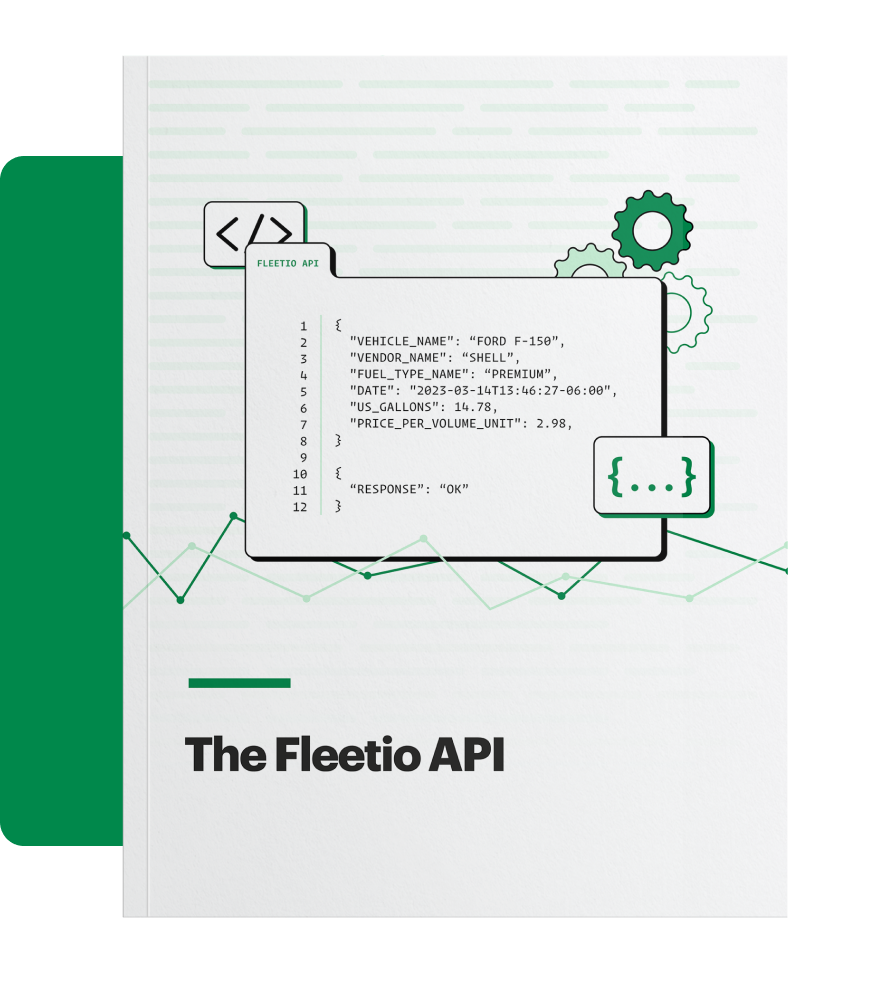Understanding Fleet APIs: Unifying Data in One Place
Fleetyr CEO Tim Hill shares what fleet managers and fleet IT professionals can gain from using APIs and automations to construct an integrated data platform for their fleets.
Aug 20, 2024
8 min read

Fleet operations should never be a guessing game, but if your data is spread over multiple different softwares, it can be tough to get a clear picture of what’s happening under the hood in your fleet. APIs can help tie everything together into an automated fleet management system and give everyone from fleet management to IT a better idea of how things actually look from a data perspective.
What is an API?
“API” is shorthand for application programming interface. APIs enable two different software components to communicate with each and exchange information in an ongoing connection. A good example of an API in everyday use is third-party hotel booking websites – the website uses APIs to get information about hotel reservations and rates that they then display on their site, and in turn, when you book a room, your booking information is then sent via API to the actual hotel you will be staying at.
In the context of fleet, APIs can be a great way to bring together all the different data points you might be working with into a single location, from telematics and GPS data to fuel card expenditures and digital work orders. Many fleet softwares have partnerships with other companies that will allow you to automatically link your data from other business platforms or send your fleet data to BI solutions, but when those don’t exist, you can use custom APIs to bridge the gap.
Why should you use APIs to unify your data?
CEO Tim Hill leads Fleetyr, a company that’s specifically focused on helping fleets clean and connect data with technology to make more informed decisions for their business. Tim has outlined a few key reasons why combining your data with APIs can help your fleet’s operations move forward more confidently and efficiently.
1. Reduce simple human errors.
The simplest answer, according to Tim, is that when you integrate data, you’re less likely to fall victim to human error.
“Segmented, you can’t get as much insights out of [your data] as you would like, and there’s the opportunity for manual manipulation before it gets to you,” he said. “And there’s also the chance that everyone makes mistakes. Humans make mistakes.”
Whether it’s from a well-intended typo or intentional misrepresentation, data can sometimes get skewed in the wrong direction if it’s being manually entered from one source to another. Those errors can make a huge difference, even with something as simple as accidentally adding an extra zero.
“So imagine if you put an extra couple of zeros on the odometer, and then you’re making all your decisions based on that vehicle being a hundred thousand kilometers older than it is… You’re using data in the wrong way. You’re trying to use it for the right things, but you’re actually using them in the wrong way and you’re making yourself less efficient.”
2. Simplify your day-to-day tasks.
Manual data entry can be a pretty arduous task that drains a lot of time out of your day, but the automation that APIs offer can be a major boon in conserving time for the tasks that matter most.
“If you have an integrated system that does all the clerical and administration work for you, then you can grab and pick the bits that you need to make your life easier,” Tim said. “That person that’s looking after your fleet, whether it’s a CEO or an ops manager or someone that’s just taken on that role, you actually get the most out of them so they can spend their time on the things that they should be spending their time on when it comes to fleet and transport operations.”
3. See your data in the correct context.
Looking at data in isolation is like looking at a photo of a person with the background blurred out – you might be able to very clearly see the subject of the photo, but you have no understanding of where they might be.
An example Tim uses is considering preventive maintenance schedules without odometer readings. It’s a lot simpler to anticipate upcoming service on PM timelines if you can quickly associate a vehicle’s most recent odometer readings with its next scheduled oil change or tire rotation. APIs allow you to sync that odometer reading you get from your telematics data with the PM schedule you’ve programmed into a platform like Fleetio, and you’ll get a notification when that service date is approaching based on the recorded mileage.
“When you have it all connected in one place, there’s a lot of insights you can grow from that,” Tim said. “For example, if you’re connecting your maintenance records with your telematics and your fuel cards… you can automatically see within probably five seconds if there’s an issue with the vehicle, so it needs to be maintained, or there’s an issue with the driver because they’re using the fuel card to fill up a different vehicle somewhere else that maybe isn’t a vehicle of the company. And then you can also see if driver behavior is actually affecting how often you have to maintain a vehicle.”
That interlocking effect lets all of your data work together, so to speak, so that you can start to see the relationships between your maintenance costs, driver behavior and fuel spending.
“So those things seem like they’d be really difficult to do if they’re all disparate and separate,” Tim said. “But if you connect everything together, you can get those insights all in about five seconds and then you can concentrate on those anomalies in your fleet. And your anomalies in your fleet are always gonna cost you a lot more than the 80-90% of drivers or vehicles that are just doing their daily job.”
Dig into the ways fleets can utilize APIs
This white paper explores APIs and their use in fleet management, how to create seamless fleet management integration in Fleetio, and example use cases for utilizing our API effectively.
Download for freeTips For Integrating Your Fleet Data with Custom APIs
Know your software’s capabilities up front.
If you’re looking to start automating the export of certain information out of one software and into another, it’s important to know that it can be done. As previously stated, a lot of providers offer integrations with select partners, but integrations can always be constructed , either internally at your company or by the company that created the software.
It’s equally important to make sure that you’re working with a provider that is not only willing to help you align all of your data, but openly recognizes that the data is yours to work with. That will not only help you unify your data, but ensure that your data is readily accessible should you ever need to switch to a new platform in the future.
“When you’re first choosing software, a big thing is to ask them, ‘How do I get my data out of here?’” Tim said. “If they say, no, it’s their data, then walk away. It is your data. It should always be your data because you are the ones creating it out of any of these systems. I tend to find software and hardware businesses that have a good data policy tend to be better software as well, just based on where they are along their journey as providers.”
Many companies, like Fleetio, offer a public API and webhooks that allows external developers to create their own solutions for linking data, while also ensuring data integrity and security. If you don’t have the resources to set up your own APIs, companies like Fleetyr can help you out, or you might even be able to seek out a new integration from your fleet management software provider if multiple customers could benefit from it.
Determine a data goal.
With the right integration, you can accomplish pretty much anything, but you need to have a clear direction of what your end goal is so you know how to set up exactly what you need.
“Your data strategy can be really simple,” Tim said. “It can be, ‘I just wanna schedule my vehicles on time, that’ll save me money.’ And there’s proof in the pudding and there’s lots of reports that show. If you’re implementing something else, particularly around fuel, again, ‘I need this maintenance platform and I need to connect it to my fuel cards so I can see where we are burning the most fuel.’ Then you can connect that to emissions. So if you’re looking into carbon credits or ways that you can save emissions –saving emissions is just saving money because you’re spending less on fuel.
“It all sort of comes back to that financial flow. So if someone says, ‘We need you to save money, go,’ you say, ‘Well, this is how I’m gonna do it,’ and then find those data points that allow you to do that.”
Keep your data clean.
One of the biggest points of failure in setting up fleet management integrations is dirty data. Tim said that about 90% of Fleetyr’s work with their clients has more to do with cleaning up data before it ever enters a new system.
“The greatest threat when it comes to data in fleets is ensuring that you set things up correctly when you first get them,” Tim said. “So implement them correctly, whether that’s putting in the right registration numbers or the right VIN numbers when you’re uploading it… maybe even checking that asset registry before you upload it.”
As you work to connect different data sources, or even implement a new software solution, you’ll want to make sure that everything is correct before assuming that the automation’s not working, or the software is failing you somehow.
“If you don’t implement your new software or new hardware correctly, or you don’t have a partner that you trust that can do it, then definitely shop around and that should be the first question that you ask. ‘How are we gonna implement this? And how do you support me along that journey?’”
Once you get that data in place, it’s important to consistently check to make sure connections are maintained, as APIs and integrations can sometimes be deprecated over time. It’s also important to ensure that the data that’s being input stays consistent, especially those fleet metrics that might be coming from a human source, like inspections.
Take advantage of Fleetio’s library of integration partners and our public API. Start your free trial or request a demo today.

Senior Fleet Content Specialist
As a Senior Fleet Content Specialist at Fleetio, Peyton explores the voices and experiences that shape fleet operations. She focuses on how fleet professionals adopt technology, improve efficiency and lead their teams to bring clarity and context to the challenges happening across the industry.
View articles by Peyton PanikReady to get started?
Join thousands of satisfied customers using Fleetio
Questions? Call us at 1-800-975-5304
